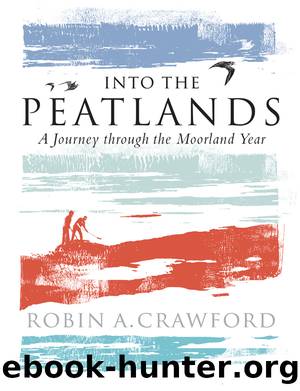Into the Peatlands by Robin Crawford

Author:Robin Crawford [Crawford, Robin]
Language: eng
Format: epub
ISBN: 9781780275598
Google: Zh2GtQEACAAJ
Publisher: Birlinn
Published: 2018-09-15T20:34:47+00:00
Defeat, Resettlement, New Lands
Look at a map of Scotland and trace the line across the narrow Central Belt, with the Firth of the River Clyde and Loch Lomond in the west and the Firth of the River Forth in the east. In between is very little land. At the eastern end of that line lies the Carse of Stirling, low-lying, next to the river, and in the centre of the vast watery mass are Blairdrummond and Flanders mosses. To the north, the geological Highland Fault Line literally separates the country, a land of mountain and flood. To the south are the Fords of Frew, an important crossing point in the Central Belt to and from the Highlands over the River Forth that has played a vital role in Scotlandâs history. Lying south of the great morass of Flanders Moss, the Fordsâ significance has been forgotten by the draining of these marshlands for agriculture over the past 250 years, but for centuries they were a vital bridging point between cultures. When the Picts invaded the lands of their southern rivals, the Strathclyde Britons, they most likely crossed into their territory via the Fords, making for the fort at Dumbarton, but as the Welsh Chronicle of the Princes relates: â750 years was the age of Christ when there was a battle between the Britons and the Picts, in the field of Maesydawc. And the Britons slew Talorcan, king of the Picts.â
In this borderland between north and south, east and west, land and water, Henry Home, Lord Kames, saw the potential of both the waterlogged moss and the poor, starving, dispossessed Highlanders. Advocate, judge, philosopher, agricultural reformer and founding member of the Philosophical Society of Edinburgh, Kames was a patron to such rising stars of the younger generation as economist Adam Smith, philosopher David Hume and biographer James Boswell. He sat as a judge on the panel which found that Joseph Knight â an African-born slave sold to a Scot in Jamaica and brought by him back to Scotland â should be freed, as Scots law did not recognise the concept that a man could be a slave. He was also on the Board of Trustees for Encouraging the Fisheries, Arts and Manufactures of Scotland and, crucially to our story, he helped to manage those estates forfeited by Jacobite landowners after the â45 uprising.
This desire to make Scottish society better, his passion for agricultural improvement and his concern for the victims of high politics, like the clanspeople of forfeited Jacobites, coincided with his wife, Agatha, inheriting her family estate at Blair Drummond (Gaelic: blar, moss) in 1766, and led to his plans to offer large tracts of Blairdrummond Moss for âimprovementâ. Kames wrote in his Essays Upon Several Subjects Concerning British Antiquities in the aftermath of the â45 that he thought the Jacobites entirely wrong in their belief that Scots society owed their loyalty to a king (or clan chief); rather it was land grants given as a reward for loyalty that built a society:
Upon succeeding to a pretty opulent fortune well stocked with people .
Download
This site does not store any files on its server. We only index and link to content provided by other sites. Please contact the content providers to delete copyright contents if any and email us, we'll remove relevant links or contents immediately.
| General | Channel Islands |
| England | Northern Ireland |
| Scotland | Wales |
Room 212 by Kate Stewart(5073)
The Crown by Robert Lacey(4764)
Endurance: Shackleton's Incredible Voyage by Alfred Lansing(4722)
The Iron Duke by The Iron Duke(4323)
The Rape of Nanking by Iris Chang(4170)
Joan of Arc by Mary Gordon(4058)
Killing England by Bill O'Reilly(3973)
Say Nothing by Patrick Radden Keefe(3939)
I'll Give You the Sun by Jandy Nelson(3398)
Shadow of Night by Deborah Harkness(3327)
Hitler's Monsters by Eric Kurlander(3293)
Mary, Queen of Scots, and the Murder of Lord Darnley by Alison Weir(3177)
Blood and Sand by Alex Von Tunzelmann(3168)
Eleanor & Park by Rainbow Rowell(3117)
Darkest Hour by Anthony McCarten(3098)
Margaret Thatcher: The Autobiography by Thatcher Margaret(3053)
Book of Life by Deborah Harkness(2895)
Red Famine: Stalin's War on Ukraine by Anne Applebaum(2894)
The One Memory of Flora Banks by Emily Barr(2834)
